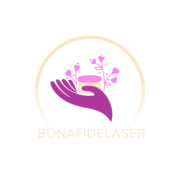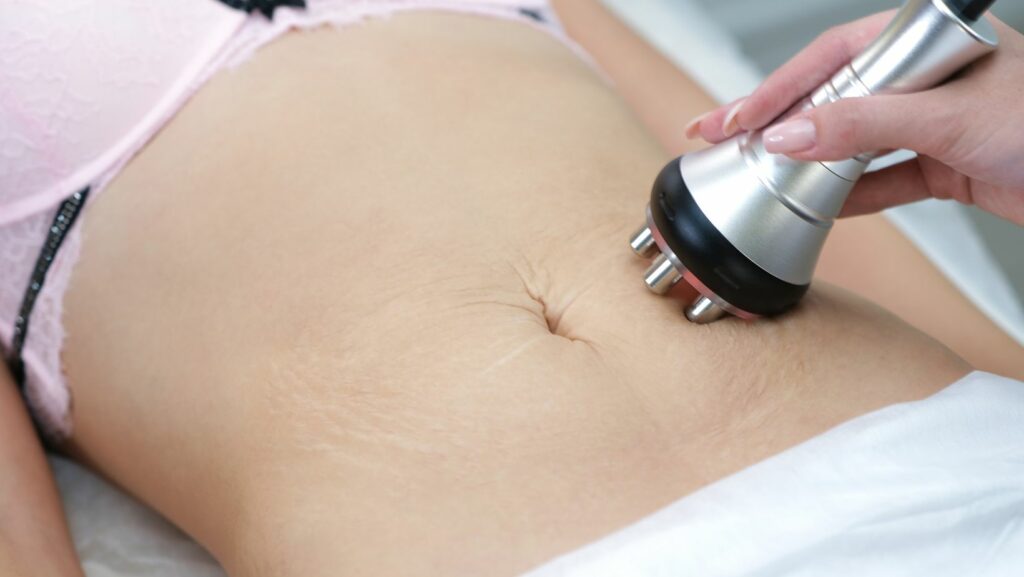![]()
![]() Laser Treatment for Stretch Marks
Laser Treatment for Stretch Marks
Stretch marks, also known as striae, are lines or streaks on the skin that occur when it stretches or shrinks rapidly. Rapid skin expansion or contraction leads to a breakdown in the skin’s collagen and elastin. Pregnancy, puberty, and significant weight changes are common causes. Initially, stretch marks appear red, purple, or dark brown depending on skin tone. Over time, they may fade to a lighter color but remain noticeable. While not harmful, many individuals seek treatment for cosmetic reasons. Stretch marks are most prevalent on the abdomen, thighs, and arms. Understanding the formation and characteristics of these marks aids in exploring treatment options like laser therapy that target increased collagen production for skin improvement. 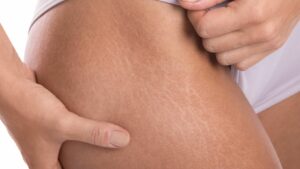
Laser treatment for stretch marks uses advanced technology to improve skin appearance. It stimulates collagen production and skin regeneration. Various laser types target stretch marks effectively. Ablative lasers, such as CO2 and Erbium YAG, remove top skin layers, enhancing skin texture. Non-ablative lasers, like Pulsed Dye and Nd:YAG, target deeper skin layers without damaging the surface, promoting collagen growth and skin tightening.
Laser treatment employs light energy to disrupt skin structures. The targeted laser heats underlying skin layers, triggering collagen synthesis and cellular regeneration. This process reduces stretch mark visibility, improving skin texture and elasticity over time. The controlled heat from the laser ensures minimal discomfort and promotes gradual skin improvement.
![]() Benefits of Laser Treatment for Stretch Marks
Benefits of Laser Treatment for Stretch Marks
Laser treatment for stretch marks offers numerous advantages for those seeking improved skin appearance. It effectively addresses texture and visibility issues associated with stretch marks, promoting smoother, more even skin. Laser therapy enhances skin texture by promoting collagen production and cellular regeneration. The controlled laser heat stimulates fibroblasts in the dermis, which are cells responsible for synthesizing collagen and elastin. This process strengthens the skin structure and increases elasticity. As the treatment progresses, skin layers remodel, resulting in a more refined texture. Patients often notice a reduction in the roughness and unevenness associated with stretch marks, leading to an overall smoother feel.
Laser treatment significantly reduces the visibility of stretch marks by targeting the dermal and epidermal layers of the skin. By inducing collagen synthesis, the treatment gradually fades the discoloration associated with stretch marks, blending them with the surrounding skin. 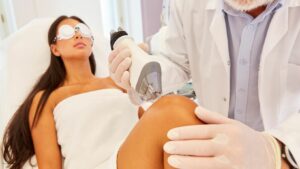 Various laser types, such as CO2 and Erbium YAG, offer precision in targeting hyperpigmented areas, whereas Pulsed Dye and Nd:YAG lasers focus on rebuilding deep skin structures. Over several sessions, many individuals experience a notable decrease in the prominence of stretch marks, making them less noticeable to the naked eye.
Various laser types, such as CO2 and Erbium YAG, offer precision in targeting hyperpigmented areas, whereas Pulsed Dye and Nd:YAG lasers focus on rebuilding deep skin structures. Over several sessions, many individuals experience a notable decrease in the prominence of stretch marks, making them less noticeable to the naked eye.
Laser treatment for stretch marks offers promising results but comes with potential risks and side effects. Common discomforts include redness, swelling, and tenderness, usually subsiding within a few days. In rare cases, patients may experience blistering or scarring, depending on individual skin sensitivity and treatment type. Hyperpigmentation or hypopigmentation can occur in some individuals, leading to darker or lighter skin patches. Individuals with darker skin tones are more susceptible to these pigment changes. Infection risk exists if post-treatment care instructions aren’t followed, emphasizing hygiene and moisturizing.
Allergic reactions are infrequent but can arise from topical anesthetics or cooling gels used during the procedure. It’s crucial to discuss allergies with a healthcare provider before treatment. Temporary changes in skin texture or sensitivity may happen, although these effects typically resolve over time as the skin heals. Considering these potential risks, consulting a qualified dermatologist or certified practitioner is essential for evaluating skin type, history, and concerns to minimize adverse effects.
![]() Comparing Laser Treatment to Other Methods
Comparing Laser Treatment to Other Methods
When addressing stretch marks, several treatment options are available. Laser treatment stands out for its high efficacy and non-invasiveness. Here’s how it compares to other popular methods. Microneedling involves using fine needles to create tiny injuries in the skin. This process stimulates collagen production and aids in skin repair. 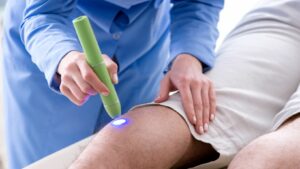 While effective, microneedling often requires multiple sessions to see noticeable results. It may also lead to temporary redness and swelling. Compared to laser treatment, microneedling is generally less expensive but may not offer the same degree of precision in targeting deeper skin layers.
While effective, microneedling often requires multiple sessions to see noticeable results. It may also lead to temporary redness and swelling. Compared to laser treatment, microneedling is generally less expensive but may not offer the same degree of precision in targeting deeper skin layers.
Topical treatments, including creams and oils, aim to moisturize and improve skin elasticity. Ingredients like hyaluronic acid and retinoids are common. However, these products usually deliver gradual improvements, mainly effective for newer stretch marks. Unlike laser treatment, topicals require consistent, long-term application to maintain results and may not significantly alter the appearance of older or more pronounced stretch marks.
